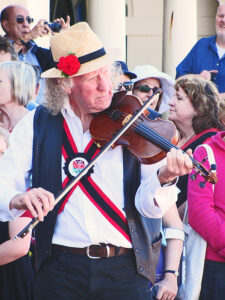Fiddle Music

Newtown grafitti from Sydney, Australia – Photo Credit: From Wikipedia
History of the Fiddle: The medieval fiddle emerged in 10th-century Europe, deriving from the Byzantine lira (Greek:λύρα, Latin:lira, English:lyre), a bowed string instrument of the Byzantine Empire and ancestor of most European bowed instruments. The first recorded reference to the bowed lira was in the 9th century by the Persian geographer Ibn Khurradadhbih (d. 911); in his lexicographical discussion of instruments he cited the lira (lūrā) as a typical instrument of the Byzantines and equivalent to the rabāb played in the Islamic Empires. Lira spread widely westward to Europe; in the 11th and 12th centuries European writers use the terms fiddle and lira interchangeably when referring to bowed instruments.
Over the centuries, Europe continued to have two distinct types of fiddles: one, relatively square-shaped, held in the arms, became known as the lira da braccio (arm viol) family and evolved into the violin; the other, with sloping shoulders and held between the knees, was the lira da gamba (leg viol) group. During the Renaissance the gambas were important and elegant instruments; they eventually lost ground to the louder (and originally less aristocratic) lira da braccio family.
Etymology of the Fiddle: The etymology of fiddle is uncertain: the Germanic fiddle may derive from the same early Romance word as does violin, or it may be natively Germanic. The name seems however to be related to Icelandic Fiðla and also Old English fiðele. A native Germanic ancestor of fiddle may even be the ancestor of the early Romance form of violin. Historically, fiddle also referred to a predecessor of today’s violin. Like the violin, it tended to have four strings, but came in a variety of shapes and sizes. Another family of instruments that contributed to the development of the modern fiddle are the viols, which are held between the legs and played vertically, and have fretted fingerboards.
Ensembles: In performance, a solo fiddler, or one fiddler or two with a group of other instrumentalists, is the norm, though twin fiddling is represented in some North American, Scandinavian, Scottish and Irish styles. Violins, on the other hand, are commonly grouped in sections. These contrasting traditions may be vestiges of historical performance settings: large concert halls where violins were played required more instruments, before electronic amplification, than did more intimate dance halls and houses that fiddlers played in.
The difference was likely compounded by the different sounds expected of violin music and fiddle music. Historically, the majority of fiddle music was dance music, while violin music had either grown out of dance music or was something else entirely. Violin music came to value a smoothness that fiddling, with its dance-driven clear beat, did not always follow. In situations that required greater volume, a fiddler (as long as they kept the beat) could push their instrument harder than could a violinist. (Different fiddle traditions have different values, as detailed below. These explanations present the differences between fiddle music and other violin music.)
Following the folk revivals of the second half of the 20th century, however, it has become common for less formal situations to find large groups of fiddlers playing together—see for example the Calgary Fiddlers, and Swedish Spelmanslag folk-musician clubs, and the worldwide phenomenon of Irish sessions.
Scottish fiddle with cello
In the very late 20th century, a few artists have successfully attempted a reconstruction of the Scottish tradition of violin and “big fiddle,” or cello. Notable recorded examples include Iain Fraser and Christine Hanson, Amelia Kaminski and Christine Hanson’s Bonnie Lasses and Alasdair Fraser and Natalie Haas‘ Fire and Grace.[11]
Balkan fiddle with kontra
Hungarian, Slovenian, and Romanian fiddle players are often accompanied by a three-stringed variant of the viola—known as the kontra—and by double bass, with cimbalom andclarinet being less standard yet still common additions to a band. In Hungary, a three stringed viola variant with a flat bridge, called the kontra or háromhúros brácsa makes up part of a traditional rhythm section in Hungarian folk music. The flat bridge allows for three string chords to be played. A three stringed double bass variant is also used.
From Wikipedia. Read more here: http://en.wikipedia.org/wiki/Fiddle
